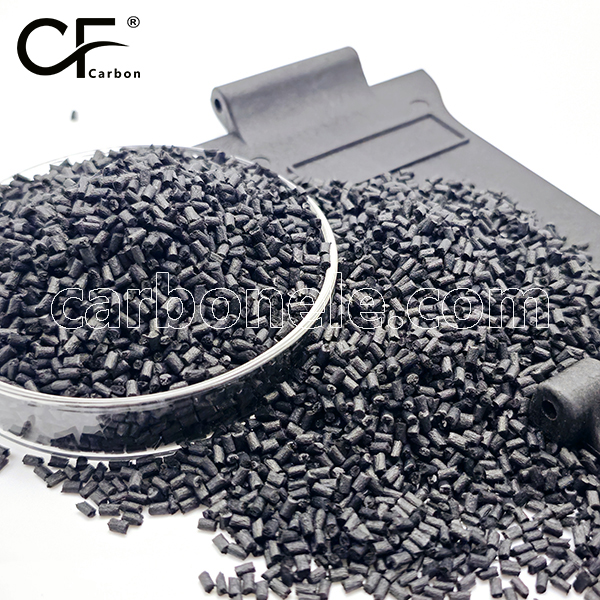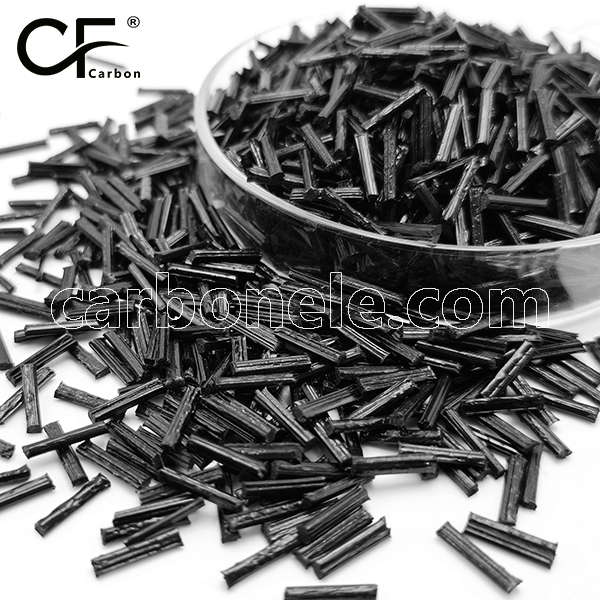
PA66-CF10 High Strength & Lightweight
PA66-CF10 is a high-performance composite material made from nylon 66 reinforced with 5% carbon fiber. It features a tensile strength of 90-120 MPa, impact strength of 60-90 kJ/m², and a wear rate of less than 0.1 mm³/kWh, making it ideal for automotive, sporting, and consumer applications.
- Model number: PA66-CF-BCA1
- Matrix Resin: Nylon6 6(Polyamide66) (PA66)
- Reinforcing Filler: Carbon fiber
- Appearance: Granules
- Grade: Injection/extrusion grade
- Packaging: 25kgs/bag
PA66-CF10 is a New Material
PA66-CF10 is a composite-reinforced plastic, created by adding 10% carbon fiber material to nylon 66 (also known as PA66).
Advantages of PA66-CF10
High Strength
PA66 CF10 has an even higher strength level than PA66 CF10. The addition of 10% carbon fiber significantly enhances its tensile strength, typically ranging between 100-140 MPa.
Lightweight
PA66 (polyamide 66) performs excellently in terms of lightweight properties. PA66 CF10 has a density typically around 1.25-1.35 g/cm³ due to the carbon fiber addition, but its increased strength allows for reduced material usage to achieve the same effects, contributing to overall weight reduction.
High Impact Resistance
PA66-CF10 offers excellent impact resistance due to the 10% carbon fiber reinforcement. Its impact strength typically ranges between 70 and 100 kJ/m², which is significantly higher than that of standard PA66.
High Wear Resistance
With a higher percentage of carbon fiber, PA66 CF10 further improves wear resistance, typically achieving a wear rate below 0.1 mm³/kWh, often between 0.05-0.08 mm³/kWh.
Application Industries
Automotive Industry
PA66 CF10’s enhanced properties make it suitable for various automotive applications, including body parts, engine components, connectors, and brackets, offering superior performance compared to both PA66 and PA66 CF10.
Sports Industry
The high strength and lightweight nature of PA66 CF10 make it ideal for use in high performance sports equipment, treadmills, gym equipment, protective gear, and footwear.
Daily Use
PA66 CF10 is also well-suited for various daily applications, including:
Furniture Parts: Providing stability and wear resistance in furniture components.
Sports Equipment: Enhancing performance and portability in home fitness gear.
Kitchen Utensils: Improving durability in knives and cookware.
Toys and Children’s Products: Ensuring safety and durability in toys and furniture.
Personal Care Products: Making razors and skincare tools more durable and lightweight.
Summary Table
Here is a summary table for PA66 CF10:
| Category | Details |
|---|---|
| Definition | PA66-CF10 is a composite-reinforced plastic with 10% carbon fiber added to nylon 66 (PA66). |
| Advantages | 1. High Strength: Tensile strength typically between 100-140 MPa. 2. Lightweight: Density around 1.25-1.35 g/cm³, reducing overall weight. 3. High Impact Resistance: Impact strength typically between 70-100 kJ/m². 4. High Wear Resistance: Wear rate typically between 0.05-0.08 mm³/kWh. |
| Industries of Application | 1. Automotive Industry: Suitable for body parts, engine components, and brackets. 2. Electronics: Used for casings, connectors, and internal parts due to excellent mechanical properties. 3. Industrial Applications: Ideal for durable and strong mechanical components and tools. 4. Consumer Goods: Commonly used in household appliances, sports equipment, and furniture fittings due to its lightweight and high strength. |
This material is well-suited for demanding applications, where enhanced strength, lightweight characteristics, and durability are essential.
If you want to get more information about PA66-CF10, you can vist our Youtube.
PA66-CF10 granules
PA66-CF10 granules typically have a round or irregular shape, with diameters generally ranging from 1 to 2 centimeters. This shape ensures uniform flow during processing, providing consistency in molding and extrusion techniques. The granules feature a smooth surface, facilitating easy mixing with other materials and enhancing their versatility across various applications. Their size also makes these granules convenient for storage and transportation, effectively minimizing space requirements. These characteristics make PA66-CF10 granules widely utilized in diverse industries, meeting various processing demands and ensuring the quality and performance of the final products.



Frequently Asked Questions
Carbon (Xiamen) New Material Co., Ltd. aims to provide buyers with "one-stop" worry-free high-quality services. Here you can find all information about carbon fiber engineering plastics. If you still have questions, please send us an email for consultation!
-
How can I contact the manufacturer of a product that interests me?
When you find a product you are interested in, you can contact the manufacturer directly by sending an email and we will get back to you as soon as possible.
-
How do I find the products that interest me?
All you need to do is enter the keyword, product name in the search window and press the Enter key on your keyboard. Your search results page will then be displayed. You can also search within the product category pages on the home page. Each category is divided into subcategories, allowing you to refine your search and find products that interest you.
-
Where will I find a buying guide?
Please contact our after-sales service directly and we will provide you with a comprehensive operating guide.
-
What are CF Reinforced Thermoplastic Composites?
CF Reinforced Thermoplastic Composites are materials where carbon fibers are incorporated into a thermoplastic matrix. They combine the strength and stiffness of carbon fibers with the processability and recyclability of thermoplastics. For instance, they are used in automotive parts like bumper beams.
-
What are the benefits of CF Reinforced Thermoplastic Composites over traditional composites?
The key benefits include faster production cycles, easier recyclability, and better impact resistance. They also offer design flexibility. An example is in the manufacturing of consumer electronics casings where complex shapes can be achieved more easily.
-
How are CF Reinforced Thermoplastic Composites processed?
Common processing methods include injection molding, extrusion, and compression molding. Injection molding is widely used for mass production. For example, in the production of small components for the medical industry.
-
What industries use CF Reinforced Thermoplastic Composites?
They are utilized in aerospace, automotive, medical, and sports equipment industries. In aerospace, they can be found in interior components. In the medical field, they might be used in prosthetics.
-
How does the carbon fiber content affect the properties of the composites?
Higher carbon fiber content generally leads to increased strength and stiffness but may reduce ductility. A moderate content is often balanced for specific applications. For example, a higher content might be preferred in structural parts of a race car.
-
What are the challenges in using CF Reinforced Thermoplastic Composites?
Challenges include higher material costs, complex processing equipment requirements, and ensuring uniform fiber dispersion. Issues with adhesion between the fibers and the matrix can also arise. An example is in achieving consistent quality in large-scale production.

























